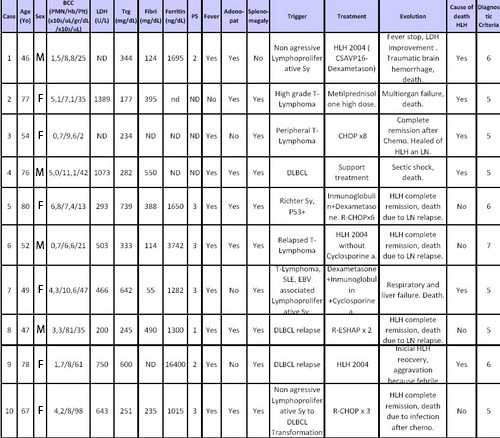
Contributions
Abstract: PB2082
Type: Publication Only
Background
Aims
Due to the lack of publications about HLH secondary to Lymphoid Neoplasms (LN), we would like to analyze the casuistry of our hospital and making a comparison with the current literature.
Methods
Results
We report 10 LN secondary cases (4 males, 6 females). The median age at diagnosis was 60,5 years, ranged between 46 and 80 years. In all of them, but in one, who presented long-term pancytopenia, symptoms were developed very fast. The most frequent causes of consultation were cytopenia and general syndrome. In two of them HLH was diagnosed with LN relapse, in one patient during a transformation from a low-grade B-cell lymphoma to DLBCL (Diffuse large B-cell lymphoma), in 6 of them we diagnosed LN and HLH concomitantly, and in the last one coinciding with a Richter Syndrome. Four of 10 were secondary to T-cell neoplasm. All patients met 5 o more HS diagnostic criteria. In only 3 of them HLH was healed. One patient is still in remission. Nine died, 7 of them due to HLH complications. Treatment was chemotherapy (depending on their LN) in almost all of them. Fluctuations were detected among activity HLH parameters due to LN response. Detailed characteristics of patients are shown in table 1.

Conclusion
HLH triggered by LN is diagnosed in older patients than other causes secondary HLH (46-80 vs. 4-84 y/o in our center), we think this is because in our experience there are not children or Young adult in HLH due to LN group. We would like to highligt that although LN is a very commom HLH trigger there are a few works describing them in the literature, that is why we would like to spread our experience. We would like to emphasize in he importance of an early diagnosis. Despite being a serious disease, it is still underdiagnosed, reaching the diagnosis most of the times after seeing hemophagocytic phenomena in bone marrow biopsy. Agreeing with literature, main consulting reasons are similar to our series. Correlation between neoplastic activity and inmune activation, as well as test and facts which could predice evolution should be more studied.
Session topic: 31. Other Non-malignant hematopoietic disorders
Keyword(s): lymphoma
Abstract: PB2082
Type: Publication Only
Background
Aims
Due to the lack of publications about HLH secondary to Lymphoid Neoplasms (LN), we would like to analyze the casuistry of our hospital and making a comparison with the current literature.
Methods
Results
We report 10 LN secondary cases (4 males, 6 females). The median age at diagnosis was 60,5 years, ranged between 46 and 80 years. In all of them, but in one, who presented long-term pancytopenia, symptoms were developed very fast. The most frequent causes of consultation were cytopenia and general syndrome. In two of them HLH was diagnosed with LN relapse, in one patient during a transformation from a low-grade B-cell lymphoma to DLBCL (Diffuse large B-cell lymphoma), in 6 of them we diagnosed LN and HLH concomitantly, and in the last one coinciding with a Richter Syndrome. Four of 10 were secondary to T-cell neoplasm. All patients met 5 o more HS diagnostic criteria. In only 3 of them HLH was healed. One patient is still in remission. Nine died, 7 of them due to HLH complications. Treatment was chemotherapy (depending on their LN) in almost all of them. Fluctuations were detected among activity HLH parameters due to LN response. Detailed characteristics of patients are shown in table 1.

Conclusion
HLH triggered by LN is diagnosed in older patients than other causes secondary HLH (46-80 vs. 4-84 y/o in our center), we think this is because in our experience there are not children or Young adult in HLH due to LN group. We would like to highligt that although LN is a very commom HLH trigger there are a few works describing them in the literature, that is why we would like to spread our experience. We would like to emphasize in he importance of an early diagnosis. Despite being a serious disease, it is still underdiagnosed, reaching the diagnosis most of the times after seeing hemophagocytic phenomena in bone marrow biopsy. Agreeing with literature, main consulting reasons are similar to our series. Correlation between neoplastic activity and inmune activation, as well as test and facts which could predice evolution should be more studied.
Session topic: 31. Other Non-malignant hematopoietic disorders
Keyword(s): lymphoma


